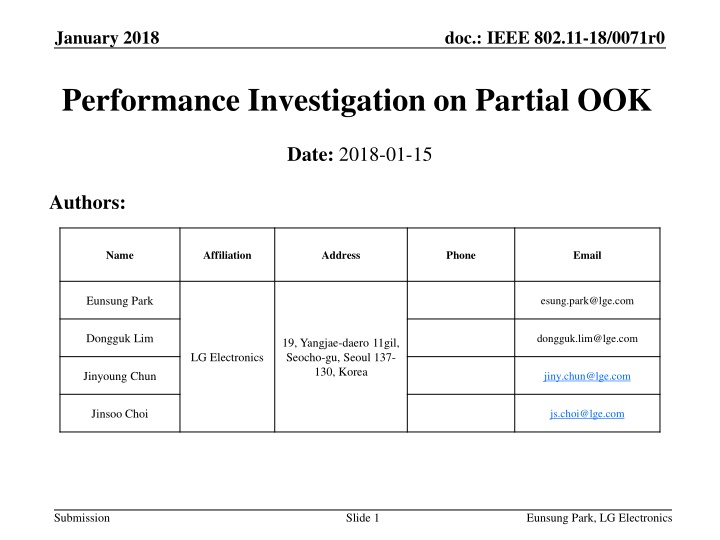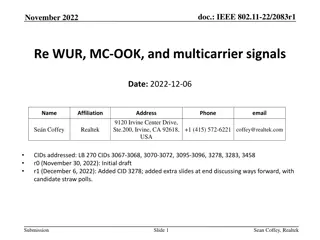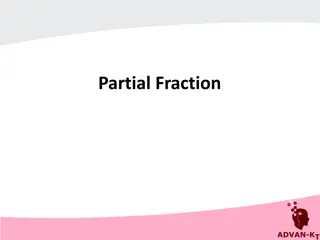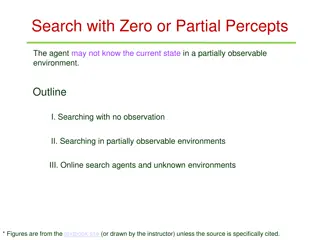
Performance Investigation on Partial OOK for High Data Rate Enhancement
Explore the performance of partial On-Off Keying (OOK) in enhancing signal quality for high data rates in wireless communications. The study delves into different structures of partial OOK, comparing their impact on Packet Error Rate (PER) and highlighting the importance of signal positioning for optimal performance. Investigations reveal the potential of partial OOK to improve Signal-to-Noise Ratio (SNR) and mitigate interference, providing valuable insights for improving data transmission efficiency.
Download Presentation

Please find below an Image/Link to download the presentation.
The content on the website is provided AS IS for your information and personal use only. It may not be sold, licensed, or shared on other websites without obtaining consent from the author. If you encounter any issues during the download, it is possible that the publisher has removed the file from their server.
You are allowed to download the files provided on this website for personal or commercial use, subject to the condition that they are used lawfully. All files are the property of their respective owners.
The content on the website is provided AS IS for your information and personal use only. It may not be sold, licensed, or shared on other websites without obtaining consent from the author.
E N D
Presentation Transcript
January 2018 doc.: IEEE 802.11-18/0071r0 Performance Investigation on Partial OOK Date: 2018-01-15 Authors: Name Affiliation Address Phone Email Eunsung Park esung.park@lge.com Dongguk Lim dongguk.lim@lge.com 19, Yangjae-daero 11gil, Seocho-gu, Seoul 137- 130, Korea LG Electronics Jinyoung Chun jiny.chun@lge.com Jinsoo Choi js.choi@lge.com Submission Slide 1 Eunsung Park, LG Electronics
January 2018 doc.: IEEE 802.11-18/0071r0 Introduction In [1][2], null CP within the ON-Signal was proposed to mitigate inter- and intra-symbol interference In [3], partial OOK which generalizes the null CP and leads to the increase in the received SNR was proposed to further enhance the performance In this contribution, we propose possible structures of the partial OOK for low and high data rates and investigate their performance in terms of the PER Submission Slide 2 Eunsung Park, LG Electronics
January 2018 doc.: IEEE 802.11-18/0071r0 Partial OOK for High Data Rate The following structure is considered The length of each partial ON-signal (the length of ON duration in each 4us symbol) is denoted as t which is shorter than 2us We assume that partial ON-signals for both info. 0 and 1 are located at the same position within the 2us ON part because different positions can cause severe ISI and intra-symbol interference For example, consider that the partial ON-Signal for info. 0 is located at the front of the symbol while the partial ON-Signal for info. 1 is located at the end of the symbol In this case, each 4us symbol can be decoded by comparing the power between first t (duration A) and last t (duration B) parts of the symbol Then, performance can be degraded since duration B in the symbol for info. 1 can cause severe interference in duration A in the following symbol Appendix A shows that partial OOK with the same position for all partial ON-signals has better performance than that with different locations according to the symbol s information Submission Slide 3 Eunsung Park, LG Electronics
January 2018 doc.: IEEE 802.11-18/0071r0 Simulation Assumption It is assumed that each partial ON-Signal is located in the middle of each 2us ON part As shown in Appendix B, this partial OOK structure has similar performance with the case where all partial ON-Signals are located at the front or at the end of 2us ON parts t is set to 1us / 0.5us The length of the decoding window (range for measuring power) is the same as t SYNC preamble is used for data rate signaling as well as packet detection and timing recovery CFO and phase noise applied Butterworth filter 2.5MHz cut off frequency, second order 20MHz sampling rate and SNR defined in 20MHz bandwidth TGnD and UMi NLoS channels in 2.4GHz Submission Slide 4 Eunsung Park, LG Electronics
January 2018 doc.: IEEE 802.11-18/0071r0 Simulation Results PER according to the partial ON-Signal length Partial OOK Performance with Real Timing for 250Kbps in TGnD Channel Partial OOK Performance with Real Timing for 250Kbps in UMi NLoS Channel 0 0 10 10 C-OOK P-OOK w/ 1us P-OOK w/ 0.5us C-OOK P-OOK w/ 1us P-OOK w/ 0.5us -1 -1 10 10 PER PER -2 -2 10 10 -3 -3 10 10 -10 -5 0 5 10 15 -10 -5 0 5 10 15 SNR [dB] SNR [dB] UMi NLoS Channel TGnD Channel Partial ON-Signal can enhance the performance and the gain of the 1us partial ON-Signal is 0.9dB / 1.7dB The shorter ON duration, the better received SNR but the more vulnerable to timing error Submission Slide 5 Eunsung Park, LG Electronics
January 2018 doc.: IEEE 802.11-18/0071r0 Partial OOK for Low Data Rate (1/3) The following options are considered Option 1 : two partial ON-Signals used for each 16us symbol based on the agreed symbol structure, i.e., flipping 4us ON/OFF parts Option 2 : only one partial ON-Signal used for each 16us symbol based on the agreed symbol structure, i.e., flipping 4us ON/OFF parts Option 3 : only one partial ON-Signal used for each 16us symbol based on the symbol structure with 8us ON/OFF parts similar to that of high data rate Submission Slide 6 Eunsung Park, LG Electronics
January 2018 doc.: IEEE 802.11-18/0071r0 Partial OOK for Low Data Rate (2/3) In option 1, The length of each partial ON-signal is denoted as T/2, i.e., the length of ON duration in each 16us symbol is T Similar to the high data rate case, all of the partial ON-signals are located at the same position within the 4us ON part For the simulation, we assume that each partial ON-Signal is located in the middle of each 4us ON part In option 3, The length of each partial ON-signal (the length of ON duration in each 16us symbol) is denoted as T Similar to the high data rate case, all of the partial ON-signals are located at the same position within the 8us ON part For the simulation, we assume that each partial ON-Signal is located in the middle of each 8us ON part Submission Slide 7 Eunsung Park, LG Electronics
January 2018 doc.: IEEE 802.11-18/0071r0 Partial OOK for Low Data Rate (3/3) In option 2, The length of each partial ON-signal (the length of ON duration in each 16us symbol) is denoted as T First and last 4us parts in each 16us symbol are used for guard interval In addition, the partial ON-Signal for info. 0 is located at the end of the second ON part while the partial ON-Signal for info. 1 is located at the front of the first ON part to further mitigate the intra-symbol interference Any other positions can cause severe intra-symbol interference For example, consider that partial ON-Signals for info. 0 and 1 are located at the front of the second ON part and at the end of the first ON part, respectively Each 16us symbol can be decoded by comparing the power between duration A and B In this case, performance can be degraded since in the symbol for info. 1 , the partial ON- signal (duration A) can cause severe interference in duration B In Appendix C, performances are shown according to locations of partial ON-Signals in option 2 Submission Slide 8 Eunsung Park, LG Electronics
January 2018 doc.: IEEE 802.11-18/0071r0 Simulation Assumption It is assumed that the following location for the partial ON-Signal is applied to each option For option 1, each partial ON-Signal is located in the middle of each 4us ON part For option 2, the partial ON-Signal for info. 0 is located at the end of the second 4us ON part while the partial ON-Signal for info. 1 is located at the front of the first 4us ON part For option 3, each partial ON-Signal is located in the middle of each 8us ON part T is set to 4us / 2us / 1us / 0.5us The length of the decoding window is the same as T Others are described in slide 4 Submission Slide 9 Eunsung Park, LG Electronics
January 2018 doc.: IEEE 802.11-18/0071r0 Simulation Results (1/4) PER for OP1 according to the partial ON-Signal length Partial OOK Performance with Real Timing for Option 1 of 62.5Kbps in TGnD Channel Partial OOK Performance with Real Timing for Option 1 of 62.5Kbps in UMi NLoS Channel 0 0 10 10 C-OOK P-OOK w/ 4us P-OOK w/ 2us P-OOK w/ 1us P-OOK w/ 0.5us C-OOK P-OOK w/ 4us P-OOK w/ 2us P-OOK w/ 1us P-OOK w/ 0.5us -1 -1 10 10 PER PER -2 -2 10 10 -3 -3 10 10 -10 -5 0 5 10 15 -10 -5 0 5 10 15 SNR [dB] SNR [dB] UMi NLoS Channel TGnD Channel 4us ON duration in each symbol (i.e., two 2us partial ON-Signals in each symbol) seems to be the best (gain 0.6dB / 0.6dB) Extremely short ON durations cause severe performance degradation since it is quite vulnerable to timing error Submission Slide 10 Eunsung Park, LG Electronics
January 2018 doc.: IEEE 802.11-18/0071r0 Simulation Results (2/4) PER for OP2 according to the partial ON-Signal length Partial OOK Performance with Real Timing for Option 2 of 62.5Kbps in TGnD Channel Partial OOK Performance with Real Timing for Option 2 of 62.5Kbps in UMi NLoS Channel 0 0 10 10 C-OOK P-OOK w/ 4us P-OOK w/ 2us P-OOK w/ 1us P-OOK w/ 0.5us C-OOK P-OOK w/ 4us P-OOK w/ 2us P-OOK w/ 1us P-OOK w/ 0.5us -1 -1 10 10 PER PER -2 -2 10 10 -3 -3 10 10 -10 -5 0 5 10 15 -10 -5 0 5 10 15 SNR [dB] SNR [dB] UMi NLoS Channel TGnD Channel 2us partial ON-Signal seems to be the best (gain 1.1dB / 1.3dB) 1us / 4us partial ON-Signals also have comparable performance Submission Slide 11 Eunsung Park, LG Electronics
January 2018 doc.: IEEE 802.11-18/0071r0 Simulation Results (3/4) PER for OP3 according to the partial ON-Signal length Partial OOK Performance with Real Timing for Option 3 of 62.5Kbps in TGnD Channel Partial OOK Performance with Real Timing for Option 3 of 62.5Kbps in UMi NLoS Channel 0 0 10 10 C-OOK P-OOK w/ 4us P-OOK w/ 2us P-OOK w/ 1us P-OOK w/ 0.5us C-OOK P-OOK w/ 4us P-OOK w/ 2us P-OOK w/ 1us P-OOK w/ 0.5us -1 -1 10 10 PER PER -2 -2 10 10 -3 -3 10 10 -10 -5 0 5 10 15 -10 -5 0 5 10 15 SNR [dB] SNR [dB] UMi NLoS Channel TGnD Channel 2us partial ON-Signal seems to be the best (gain 1.3dB / 1.4dB) 1us / 4us partial ON-Signals also have comparable performance Submission Slide 12 Eunsung Park, LG Electronics
January 2018 doc.: IEEE 802.11-18/0071r0 Simulation Results (4/4) PER comparison with 2us partial ON-Signal Partial OOK Performance with Real Timing for 62.5Kbps in UMi NLoS Channel Partial OOK Performance with Real Timing for 62.5Kbps in TGnD Channel 0 0 10 10 C-OOK P-OOK OP1 P-OOK OP2 P-OOK OP3 C-OOK P-OOK OP1 P-OOK OP2 P-OOK OP3 -1 -1 10 10 PER PER -2 -2 10 10 -3 -3 10 10 -10 -5 0 5 10 15 -10 -5 0 5 10 15 SNR [dB] SNR [dB] UMi NLoS Channel TGnD Channel For option 1, two 2us partial ON-Signals are considered in each 16us symbol All of the options are better than the normal OOK Option 3 seems the best and option 2 is comparable Submission Slide 13 Eunsung Park, LG Electronics
January 2018 doc.: IEEE 802.11-18/0071r0 Conclusion We have proposed several partial OOK symbol structures for low and high data rates and investigated their performance Partial OOK can enhance the performance for both low and high data rates because much higher received SNR can be achieved However, the length of the partial OOK signal needs to be properly set for better performance The partial OOK with extremely short length of the partial ON-Signal can aggravate the performance and have even worse performance than that of the normal OOK because it requires quite accurate timing 1us and 2us partial ON-Signals seem to be suitable for high and low data rates, respectively In addition, for the low data rate case, we could come up with the current symbol structure based partial OOK (i.e., option 2) which offers comparable performance Submission Slide 14 Eunsung Park, LG Electronics
January 2018 doc.: IEEE 802.11-18/0071r0 References [1] IEEE 802.11-17/1347r3 Symbol Structure [2] IEEE 802.11-17/1390r1 Blank GI choices under Timing Errors [3] IEEE 802.11-17/1673r1 Partial OOK Generalizing the Blank GI Idea Submission Slide 15 Eunsung Park, LG Electronics
January 2018 doc.: IEEE 802.11-18/0071r0 Appendix Submission Slide 16 Eunsung Park, LG Electronics
January 2018 doc.: IEEE 802.11-18/0071r0 Appendix A Performance Comparison According to Locations of Partial ON-Signals in High Data Rate Options Case 1 : Both partial ON-Signals for info 0 and 1 are located in the middle of the 2us ON part Case 2 : Partial ON-Signals for info 0 and 1 are located at the front and at the end of the 2us ON part, respectively Case 3 : Partial ON-Signals for info 0 and 1 are located at the end and at the front of the 2us ON part, respectively Submission Slide 17 Eunsung Park, LG Electronics
January 2018 doc.: IEEE 802.11-18/0071r0 Appendix A Performance Comparison According to Locations of Partial ON-Signals in High Data Rate PER Partial OOK Performance with Real Timing for 250Kbps in TGnD Channel Partial OOK Performance with Real Timing for 250Kbps in UMi NLoS Channel 0 0 10 10 C-OOK P-OOK Case 1 P-OOK Case 2 P-OOK Case 3 C-OOK P-OOK Case 1 P-OOK Case 2 P-OOK Case 3 -1 -1 10 10 PER PER -2 -2 10 10 -3 -3 10 10 -10 -5 0 5 10 15 -10 -5 0 5 10 15 SNR [dB] SNR [dB] UMi NLoS Channel TGnD Channel Submission Slide 18 Eunsung Park, LG Electronics
January 2018 doc.: IEEE 802.11-18/0071r0 Appendix B Performance Comparison According to Locations of Partial ON-Signals in High Data Rate Options Case 1 : Partial ON-Signal in the middle of the 2us ON part Case 2 : Partial ON-Signal at the front of the 2us ON part Case 3 : Partial ON-Signal at the end of the 2us ON part Submission Slide 19 Eunsung Park, LG Electronics
January 2018 doc.: IEEE 802.11-18/0071r0 Appendix B Performance Comparison According to Locations of Partial ON-Signals in High Data Rate PER Partial OOK Performance with Real Timing for 250Kbps in UMi NLoS Channel Partial OOK Performance with Real Timing for 250Kbps in TGnD Channel 0 0 10 10 C-OOK P-OOK Case 1 P-OOK Case 2 P-OOK Case 3 C-OOK P-OOK Case 1 P-OOK Case 2 P-OOK Case 3 -1 -1 10 10 PER PER -2 -2 10 10 -3 -3 10 10 -10 -5 0 5 10 15 -10 -5 0 5 10 15 SNR [dB] SNR [dB] UMi NLoS Channel TGnD Channel Submission Slide 20 Eunsung Park, LG Electronics
January 2018 doc.: IEEE 802.11-18/0071r0 Appendix C Performance Comparison According to Locations of Partial ON-Signals in Low Data Rate Options Case 1 : Partial ON-Signals for info 0 and 1 are located at the end and at the front, respectively Case 2 : Both partial ON-Signals for info 0 and 1 are located in the middle Case 3 : Partial ON-Signals for info 0 and 1 are located at the front and at the end, respectively Submission Slide 21 Eunsung Park, LG Electronics
January 2018 doc.: IEEE 802.11-18/0071r0 Appendix C Performance Comparison According to Locations of Partial ON-Signals in Low Data Rate PER Partial OOK Performance with Real Timing for 62.5Kbps in TGnD Channel Partial OOK Performance with Real Timing for 62.5Kbps in UMi NLoS Channel 0 0 10 10 C-OOK P-OOK Case 1 P-OOK Case 2 P-OOK Case 3 C-OOK P-OOK Case 1 P-OOK Case 2 P-OOK Case 3 -1 -1 10 10 PER PER -2 -2 10 10 -3 -3 10 10 -10 -5 0 5 10 15 -10 -5 0 5 10 15 SNR [dB] SNR [dB] UMi NLoS Channel TGnD Channel Submission Slide 22 Eunsung Park, LG Electronics






















